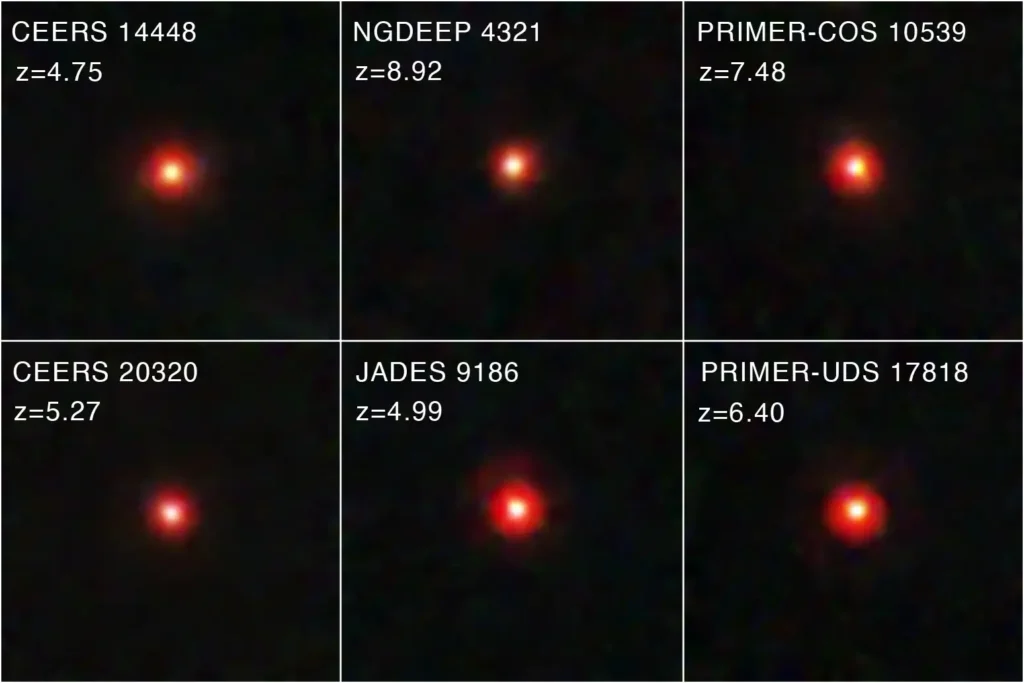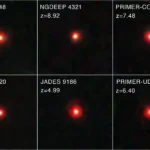The James Webb Space Telescope has provided an unprecedented glimpse into the earliest phases of galactic evolution within the cosmos.
It has likewise uncovered several unexpected phenomena, one of which involves compact, intensely redshifted entities informally termed “little red dots (LRDs).”

Although their precise nature remains elusive, recent research offers a potential explanation.
One established characteristic of these enigmatic bodies is their broad spectral profiles, influenced extensively by motional Doppler effects. This spectral broadening signifies that the luminous gas is undergoing rapid rotation around a central core, exhibiting orbital velocities surpassing 1,000 kilometers per second. Such dynamism implies the presence of a supermassive black hole, which likely serves as the driving force behind active galactic nuclei (AGN). However, the AGN paradigm presents challenges when applied to LRDs, as their infrared emission appears unusually uniform. Furthermore, they demonstrate minimal activity within both X-ray and radio wavelengths, an anomaly for typical AGN behavior.
To probe this discrepancy, the newly conducted analysis investigated twelve LRDs for which the JWST has obtained high-resolution spectral data. These observations were systematically compared against theoretical models of supermassive black hole dynamics.
The modeling framework postulated the existence of a rapidly rotating accretion disk surrounding a black hole ensconced within a primordial galactic cloud. Initial results indicated that the encircling cloud must possess a high degree of ionization. A dense aggregation of free electrons would effectively absorb the majority of both X-ray and radio emissions.
Naturally, for such a dense veil to obscure high-energy radiation, the central black hole would be required to generate immense energy output, sufficient to render the LRDs visibly luminous in the red and infrared spectra.
Empirical findings suggest these black holes are likely accreting matter at rates nearing the Eddington Limit—a fundamental threshold beyond which radiation pressure exceeds gravitational pull, thereby expelling surrounding matter instead of drawing it inward.
This confluence of evidence supports a hypothesis wherein LRDs represent nascent supermassive black holes undergoing rapid mass accumulation. Mass estimates derived from this recent investigation place these black holes in the range of 10,000 to 1,000,000 solar masses, markedly smaller than the more mature and massive counterparts observed in established galaxies.
Such a developmental model may also elucidate the absence of LRDs at lower redshifts. Accretion at or near the Eddington threshold would swiftly dissipate the surrounding ionized envelope.
Once this obscuring medium is eliminated, the LRDs would progressively exhibit characteristics akin to conventional active galactic nuclei observed throughout the observable universe.
What are the little red dots in the universe?

The little red dots (LRDs) are compact, highly redshifted celestial objects detected by the James Webb Space Telescope (JWST). They are believed to represent an early developmental stage of supermassive black holes, embedded within young, ionized galactic clouds. Their distinct spectral characteristics—particularly their broad emission lines caused by Doppler motion—suggest that they harbor rapidly rotating material orbiting central black holes. These objects emit primarily in the infrared and red wavelengths, but lack the typical X-ray and radio signatures of standard active galactic nuclei (AGN), pointing to their unique and nascent nature.
What are the little red dots in the sky?
When observed through advanced telescopes like JWST, the little red dots visible in the distant cosmos are hypothesized to be young supermassive black holes in the process of rapid mass accretion. Their red appearance stems from their high redshift, indicating that they are extremely distant and thus seen as they were in the early universe. These entities are enveloped in dense ionized gas, which absorbs X-rays and radio waves, making them prominent only in the infrared spectrum.
Were there black holes in the early universe?
Yes, current astronomical evidence strongly suggests that black holes existed in the early universe. The detection of little red dots by JWST supports the theory that supermassive black holes began forming at very early cosmic epochs. These early black holes likely grew rapidly, accreting matter at rates close to the Eddington Limit, and were initially obscured by thick ionized clouds. Their presence plays a crucial role in understanding galaxy formation and the evolution of cosmic structures
What are the red dots found by JWST?
The red dots identified by the James Webb Space Telescope are believed to be early-stage supermassive black holes shrouded in ionized gas clouds. Known as little red dots (LRDs), they exhibit broad spectral lines indicative of high rotational speeds and significant gravitational influence, typical of black holes. Unlike mature AGN, these objects show minimal X-ray and radio emissions due to absorption by the surrounding cloud, but appear bright in the red and infrared regions of the spectrum.
What is the difference between a red hole and a black hole?
The term “red hole” is not a standard scientific designation and does not refer to a formally recognized astrophysical object. In contrast, a black hole is a well-defined region in space where gravitational pull is so strong that not even light can escape. The so-called little red dots or “red holes” observed by JWST are not a distinct type of hole but rather early black holes appearing red due to high redshift and emission in infrared wavelengths. Thus, the key difference lies in terminology and observational context, not physical nature.
What are the red things in space?
Red objects in space can result from various phenomena. In the context of the JWST findings, the red appearance of little red dots is attributed to their high redshift, signifying great cosmic distance and age. Other red features in space include red giants, nebulae illuminated by ionized hydrogen (H-alpha emission), and galaxies receding at high velocities. However, the little red dots are notable for their compactness, spectral behavior, and potential role as early supermassive black holes.
